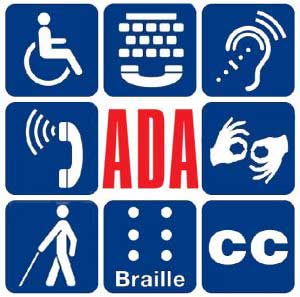In September 2010, the US Department of Justice (DOJ) published the Americans with Disabilities Act (ADA) to prohibit discrimination against individuals with disabilities in all areas of public life. This includes schools, jobs, transportation and all public and private places open to the general public.
of Justice (DOJ) published the Americans with Disabilities Act (ADA) to prohibit discrimination against individuals with disabilities in all areas of public life. This includes schools, jobs, transportation and all public and private places open to the general public.
Under the ADA, companies that provide goods and services to the public are required to “take certain limited steps to improve and maintain access to existing places of business.” It was enacted to ensure that people with disabilities have the same rights and opportunities as everyone else, and provide equal opportunity for individuals with disabilities in public accommodations, transportation, employment, state and local government services, and telecommunications.
“Title III of the ADA (public accommodations) sets the minimum standards for accessibility for alterations and new construction of facilities. It also requires public accommodations to remove barriers in existing buildings where it is easy to do so without much difficulty or expense, and directs businesses to make “reasonable modifications” to their usual ways of doing things when serving people with disabilities.”
Simple solutions for ADA compliance can include changing out round doorknobs for levered ones, adding ramps to provide accessibility over steps, curbs and thresholds, creating an accessible parking space, widening an entrance door or installing visual alarms and raised buttons on elevator control panels. A checklist for existing facilities can be found here.
For What Buildings Does the ADA Require Accessibility?
The ADA contains many requirements not found in building codes, and many building owners and managers believe the ADA only applies to new construction or renovations. Or believe that buildings erected prior to the Act need not comply. That is not true; all public buildings need to be accessible. For ADA non-compliance, the courts will take into account a number of factors (42 U.S.C. Section 12181(9)) determining whether the removal of barriers is “easily accomplishable and able to be carried out without much difficulty or expense.”
Are Historic Properties Exempt from ADA Compliance?
According to a brief titled Making Historic Properties Accessible by Technical Preservation Services (TPS), “Historic properties are not exempt from the ADA requirements. To the greatest extent possible, historic buildings must be as accessible as non-historic buildings.”
“Modifications may be as simple as a small, inexpensive ramp to overcome one entrance step, or may involve changes to exterior and interior features.” However, in order to preserve the national interest in preserving historic properties, alternative requirements were established by Congress for properties “that cannot be made accessible without ‘threatening or destroying’ their significance.
Accessibility solutions for a historic property can include among them:
- Convenient parking
- Accessibility routes
- Creation of an accessible entrance
- Adding ramps and wheelchair lifts
- Adapting door hardware
- Altering door thresholds
- Repositioning shelves, displays and furniture
- Upgrading restrooms with grab bars, maneuverability space, and accessible sinks and paper towel dispensers
Contact Först Consulting Group
Today, several federal accessibility laws are in effect: Architectural Barriers Act (1968), Rehabilitation Act (1973), and the Americans with Disabilities Act (1990), and building owners and managers need to ensure that their building meets the requirements set forth by these laws.
For questions about the Americans with Disabilities Act and its requirements for public building compliance, please contact Först Consulting Group. As a construction expert, we can help identify remedies to meet ADA requirements. Contact us today.


